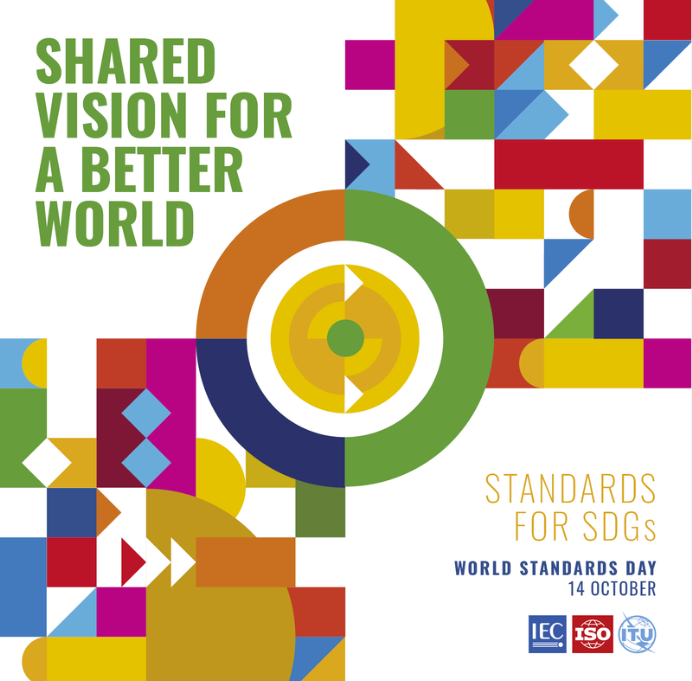Every year, on 14 October the international standardization community celebrates World Standards Day. This event is a means of paying tribute to the collaborative efforts of thousands of experts worldwide whose work contributes to the development of voluntary standards.
Under the motto ‘Shared Vision for a Better World’, for the past years, World Standards Day has been dedicated dedicated to raising awareness on how standards support the Sustainable Development Goals (SDGs). Now, for 2023 the focus is on SDG 3 ‘Good Health and Well-Being’.
CEN and CENELEC, as two of the official European Standardization Organizations (ESOs), are happy to join the celebration. We strongly believe in the power of standards to support healthy lifestyles and promote the well-being of all: throughout our history, we have been in the frontline developing standards that support SDG 3.
What follows are some examples of such standards: each one of them covering a different sector and with a different scope, they all contribute to creating a better life for many.
- EN ISO 15384:2020 ‘Protective clothing for firefighters - Laboratory test methods and performance requirements for wildland firefighting clothing’
This standard protects firefighters during hazardous wildfire operations. Its latest update, developed by CEN/TC 162 ‘Protective clothing including hand and arm protection and lifejackets’, has improved the textiles involved in manufacturing the garments to provide additional levels of protection.
Thanks to this, the safety of firefighters undertaking dangerous wild fires is massively increased, which contributes to reduce the normally large number of losses of firefighter lives during such operations.
Also, as it is an EN ISO, it has a de facto global value, which means that manufacturers can develop products that can be sold all around the world.
- The EN 556 series on the sterilization of medical devices
This series consists of two standards, developed by CEN/TC 204 ‘Sterilization of medical devices’:
- EN 556-1:2001/AC:2006(WI=00204C04) ‘Sterilization of medical devices - Requirements for medical devices to be designated 'STERILE' - Part 1: Requirements for terminally sterilized medical devices’;
- And EN 556-2:2015(WI=00204059) ‘Sterilization of medical devices - Requirements for medical devices to be designated ''STERILE" - Part 2: Requirements for aseptically processed medical devices’
The importance of these two standards is because often medical devices must be supplied in a sterile manner. This is important to ensure that there is a reduced risk to patients from microbiological contaminations. Sterility can be achieved by applying a sterilization process to a packaged item, resulting in terminally sterilized items, or combining already sterilized items while preventing recontamination, termed aseptic processing. EN 556 covers both processes: Part 1 provides requirements for a terminally sterilized medical device to be designated as ‘sterile’, while Part 2 specifies the requirements for an aseptically processed medical device to be designated as such.
It is important that there is a validated and accurately controlled sterilization process meeting recognised criteria to provide assurance that the medical device in fact is sterile and, in this respect, suitable for its intended use.
This family of standards can support manufacturers identify acceptable criteria for the potential for the presence of micro-organisms on/in the device in order for it to be considered and designated "sterile". This provides clear criteria for manufacturers, regulatory bodies and users across Europe when manufacturing or purchasing a device that requires to be sterile before usage.
- CEN/TS 17470:2020 ‘Service model for social care alarms’
This Technical Specification (TS), developed by CEN/TC 431‘Service Chain for Social Care Alarms’, provides a framework and some recommendations for the roles and responsibilities of the different actors in the social care alarm service chain.
This document takes the entire service chain into consideration: it builds on the premise that the service user should be at the centre of service provision and their experience should define service design and quality. Indeed, a customer or a service user normally experiences the entire service chain; as a consequence, the quality of a service can only be managed and evaluated by holistic assessment of the whole service chain and not just its elements in isolation.
This document considers the entire service chain, regardless of technology and organisational structures, since clearly defined leadership, roles and responsibilities between actors are a key success factor for the overall quality of the service processes. Finally, it creates a path for future service development, as the needs of service users evolve and the services evolve to meet these changing needs and expectations.
This approach is important for all involved parties, from user to provider, to know who is responsible for what, to have a view of the whole service chain, and to follow the user through the process, from detection of need to possible termination of service. It facilitates good practice of service provision via quality and risk management, including security and privacy, and requirements for infrastructure.
CEN/TS 17470:2020 contributes to SDG3 by providing a framework and recommendations, which clarify, for all involved parties, how to organise the service to make it accessible. It also strengthens the safety of the service provided to the user, through clear process descriptions.
- CEN/TS 17500:2021 ‘Quality of care and support for older persons’
This Technical Specification, developed by CEN/TC 449 ‘Quality of care for older people’, includes requirements and recommendation on the provision of services of care and support to older persons. Its aim is to promote the idea that every older person has the right to age with dignity, to be respected and to be included as a full member of society.
Care and support normally focuses on meeting the older person’s basic needs, such as eating, showering or dressing. The specification takes into account that broader objectives of ensuring wellbeing, that life has meaning, and that the older person feels respected are just as important.
More specifically, the specification is based on the approach that the care and support must evolve in radical ways if the growing needs of older persons are to be sustainably met. This transformation will require a coordinated and multisectoral response that involves a wide range of stakeholders, both within and outside governments.
Implementing the specification as a service provider or using it to support the quality of health service in care homes, and in home care offers the potential for improving the quality of life for the growing population of older persons, while reducing the economic burden on the health system.
- EN 17398:2020 ‘Patient involvement in healthcare – Minimum requirements for person-centred care’
With CEN and CENELEC addressing an increasing number of healthcare-related issues through European standards, the collaboration with ANEC ensures the collective consumer voice is heard in the relevant standardization activities.
In the context of disease prevention and health promotion in an ageing population, ANEC sees an important role in the application of European standards for person-centred care.
In particular, ANEC contributed to EN 17398, developed by CEN/TC 450 ‘Patient involvement in person-centred care’. This is a standard that focuses on specifying minimum requirements to enable patient involvement, a key aspect in facilitating person-centred care. As such, special attention is given to the partnership between patient and health care personnel, the patient's story/narrative and the importance of information sharing and documentation. The standard does not impact on the medical profession to any extent.
ANEC expressed agreement with the current philosophy and requirements: this first standard on person-centred care is a valuable first step in this field. The standard is intended to be applicable to different types of health care services such as hospital care, general practice, primary care centres, dental practices etc., and does not exclude its potential use in social care.
This article was written thanks to the support and contributions of the following people: David Matthews - Fire & Industrial PPE Ltd - convenor of CEN/TC 162/WG 2 ‘Resistance to heat and fire of protective clothing’; Nele Zvac, secretary of CEN/TC 204 - Sterilization of medical devices; Kristofer Petraeus, Secretary of CEN/TC 431 ‘Service Chain for Social Care Alarms’; Alexandra Antoni, secretary of CEN/TC 449 - Quality of care for older people; Marijana Antarorova at ANEC; and Jennifer Ogbonna and Christina Thorngreen at the CEN and CENELEC Management Centre.




